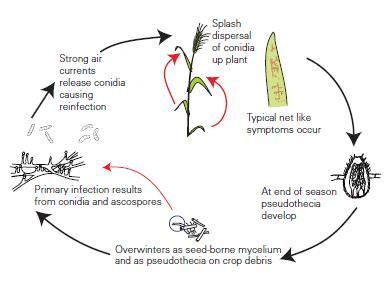Appearance and life-cycle
Net blotch occurs in two forms, one producing a network of necrosis on leaves extending mostly along the veins and partly across the veins of the leaf (termed the net form) and the other causing smaller discrete dark spots (termed the spot form). Both also produce chlorosis around infected areas as the infection matures.
Early symptoms are similar to Ramularia so diagnostic tests or close examination of spores may be needed to confirm identification.
On juvenile plants, particularly emerging crops, the disease may also appear as a brown stripe extending from the leaf base to the tip, similar to leaf stripe.

Pictures and diagram of net blotch life cycle taken from The encyclopaedia of cereal diseases (2020) AHDB
The disease can spread on seeds but the main source of inoculum is infected stubble and volunteers, from which rain-splashed spores (conidia) and wind-blown spores (ascospores) are dispersed.
Some varieties are much more susceptible than others.
Symptoms can be severe on winter leaves but dry conditions in spring can allow the crop to grow away from senesced lower leaves depending on crop protection, cultivar resistance and weather.
Yield losses can reach 50% in Australia and significant losses can also occur in Europe.
Management Options
Separation of new crops from debris of previous crops is essential especially if minimal tillage is used. In particular, second barley crops should be avoided if the disease was established on the first crop.
Seed should be tested for disease presence and if necessary, treated with a fungicide seed treatment.
No variety is currently completely resistant to net blotch but some are moderately resistant which should reduce disease impact greatly. Cultivar resistance for winter barley ranges from 4-6 in the AHDB Recommended List. Currently (in 2022) the most resistant cultivars include Craft, KWS Hawking, California, Valerie, SY Thunderbolt, SY Kingston and KWS Feeris.
Nitrogen applications should be managed to avoid elevated N levels, which encourage the disease.
Fungicides are recommended to prevent late infections of upper leaves. Some azoles such as prothioconazole, SDHIs mixed with azoles are currently effective (2022). Strobillurins are usually not effective as a fungicide but may still enhance crop productivity when used with effective fungicides. Current fungicide performance for barley is presented in the Foliar fungicide activity and seed treatment options for barley | AHDB.
Currently it is recommended to mix products with two or more modes of action or to use products with different modes of action at different spray times in order to manage fungicide resistance.